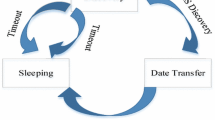Abstract
We consider providing presence service for duty-cycled wireless sensor networks through a multihop approach. The presence service is to ensure automatic network monitoring by which each node would know whether the sink node is reachable or not. Towards providing such presence service, we tackle three problems: 1) efficient neighbor discovery due to not-always-awake nature of duty-cycling and the mobile environment, 2) light presence message passing from the sink node to all reachable nodes given broadcasting is expensive and difficult in an embedded duty-cycling network, and 3) automatic network monitoring if there is node failure and network partition. In our protocol, in order to save power consumption, an online node which is reachable from the sink node only book-keeps the broadcast schedule of its parent in a breadth-first-search spanning tree in order to trace the online status all along. The offline node which is not reachable from the sink node stays awake periodically based on quorum-based wakeup scheduling, and probes the beacons which may come from online nodes. The presence protocol can automatically detect link failure or network partition, and it can also automatically recover online status for each sensor node if there is a path to the sink node, which is significant for applications that are sensitive to end-to-end latency constraints. The presence protocol proposed is implemented through a layered approach so that it is independent from any specific MAC and routing protocols. We make extensive simulations in order to validate the energy efficiency and reliability of our design.











Similar content being viewed by others
References
Song H, Kim D, Lee K, Sung J (2005) UPnP-based sensor network management architecture and implementation. In: Second international conference on mobile computing and ubiquitous networking
Ruiz L, Nogueira J, Loureiro A (2003) Manna: a management architecture for wireless sensor networks. IEEE Commun Mag 41(2):116–125
Tolle G, Culler D (2005) Design of an application-cooperative management system for wireless sensor networks. In: EWSN, pp 121–132
Ramanathan N, Yarvis M, Chhabra J, Kushalnagar N, Krishnamurthy L, Estrin D (2005) A stream-oriented power management protocol for low duty cycle sensor network applications. In: EmNets, pp 53–61
Lamport L (1978) Time, clocks, and the ordering of events in a distributed system. Commun ACM 21(7):558–565
Deng J, Han R, Mishra S (2006) Secure code distribution in dynamically programmable wireless sensor networks. In: IPSN, pp 292–300
Day M, Rosenberg J, Sugano H (2000) A model for presence and instant messaging. IETF RFC 2778, February
He T et al (2006) Achieving real-time target tracking using wireless sensor networks. IEEE RTAS 0, 37–48
Lai S, Zhang B, Ravindran B, Cho H (2008) Cqs-pair: cyclic quorum system pair for wakeup scheduling in wireless sensor networks. In: International conference on principles of distributed systems (OPODIS), vol 5401. Springer, pp 295–310
Ye W, Heidemann J, Estrin D (2004) Medium access control with coordinated adaptive sleeping for wireless sensor networks. IEEE/ACM Transactions on Networking 12:493–506
Polastre J, Hill J, Culler D (2004) Versatile low power media access for wireless sensor networks. In: ACM Sensys, pp 95–107
Shaila K, Yeri V, Arjun A, Venugopal K, Patnaik L (2010) Adaptive mobility and availability of a mobile node for efficient secret key distribution inwireless sensor networks. In: Second international conference on machine learning and computing (ICMLC), pp 137 –141
Tseng Y, Hsu C, Hsieh T (2002) Power-saving protocols for ieee 802.11-based multi-hop ad hoc networks. In: IEEE International Conference on Computer Communications (INFOCOM), pp 200–209
Zheng R, Hou JC, Sha L (2003) Asynchronous wakeup for ad hoc networks. In: MobiHoc, pp 35–45
Dutta P, Culler D (2008) Practical asynchronous neighbor discovery and rendezvous for mobile sensing applications. In: Sensys, pp 71–84
Niven I, Zuckerman HS, Mongomery HL (1991) Introduction to the theory of numbers. John Wiley & Sons
Rhee I, Warrier A, Min J, Xu L (2006) Drand: distributed randomized tdma scheduling for wireless ad-hoc networks. In: MobiHoc, pp 190–201
Krumke SO, Marathe MV, Ravi SS (2001) Models and approximation algorithms for channel assignment in radio networks. Wirel Netw 7(6):575–584
Kubale M, Kuszner L (2002) A better practical algorithm for distributed graph coloring. In: International conference on parallel computing in electrical engineering (PARELEC), pp 72–75
Sommer P, Wattenhofer R (2009) Gradient clock synchronization in wireless sensor networks. In: The international conference on information processing in sensor networks (IPSN), pp 37–48
Luk W, Huang T (1997) Two new quorum based algorithms for distributed mutual exclusion. In: ICDCS, pp 100–106
Parthasarathy S, Gandhi R (2004) Distributed algorithms for coloring and domination in wireless ad hoc networks. In: FSTTCS, pp 447–C459
Sur S, Srimani PK, Srimani PK (1992) A self-stabilizing distributed algorithm to construct BFS spanning trees of a symmetric graph. Comput Math Appl 30:171–179
Zuniga M, Krishnamachari B (2004) Analyzing the transitional region in low power wireless links. In: IEEE SECON, pp 517–526
Johnson DB, Maltz DA (1996) Dynamic source routing in ad hoc wireless networks. Mobile Computing, Kluwer Academic Publishers, pp 153–181
Yoon J, Liu M, Noble B (2003) Random waypoint considered harmful. In: IEEE INFOCOM, vol 2, pp 1312–1321
Acknowledgements
This work was supported by the Ministry of Knowledge Economy (MKE) of South Korea. [2008-F-052, Scalable/Mobile/Reliable WSN Technology].
Author information
Authors and Affiliations
Corresponding author
Rights and permissions
About this article
Cite this article
Lai, S., Ravindran, B. An Automatic Presence Service for Low Duty-Cycled Mobile Sensor Networks. Mobile Netw Appl 16, 460–474 (2011). https://doi.org/10.1007/s11036-011-0326-2
Published:
Issue Date:
DOI: https://doi.org/10.1007/s11036-011-0326-2




